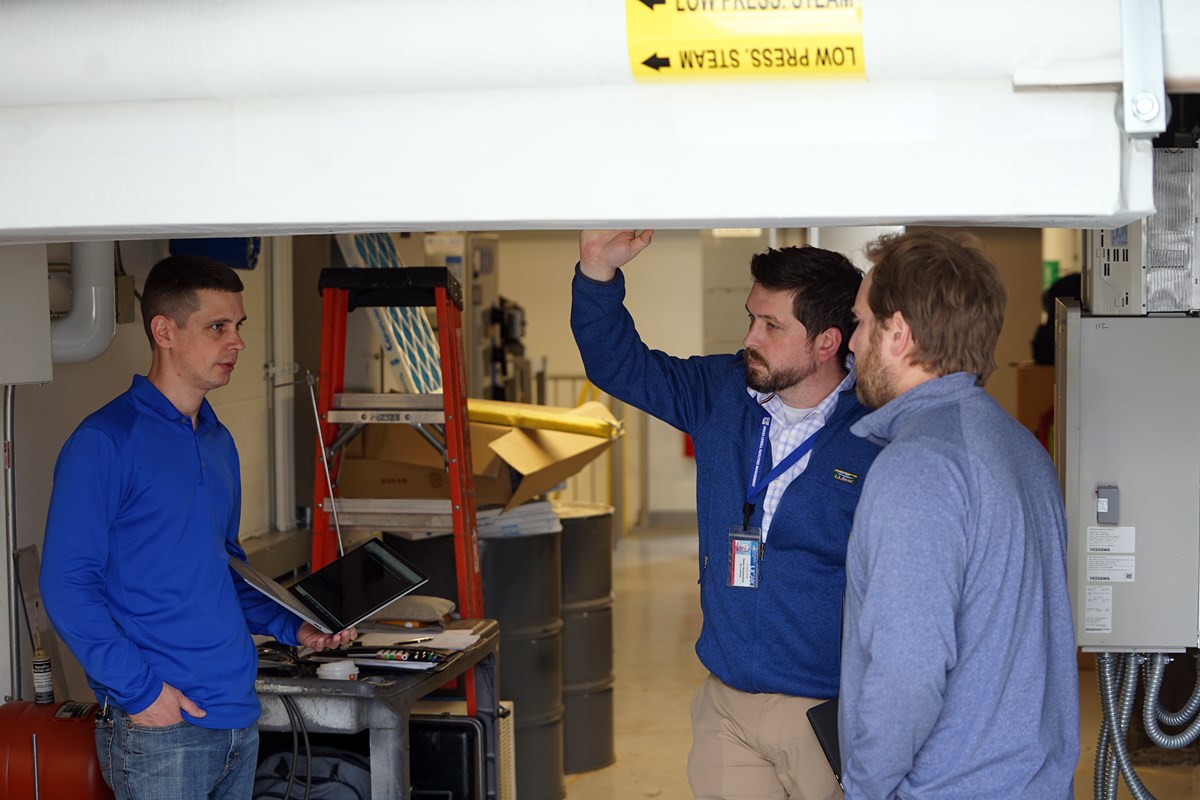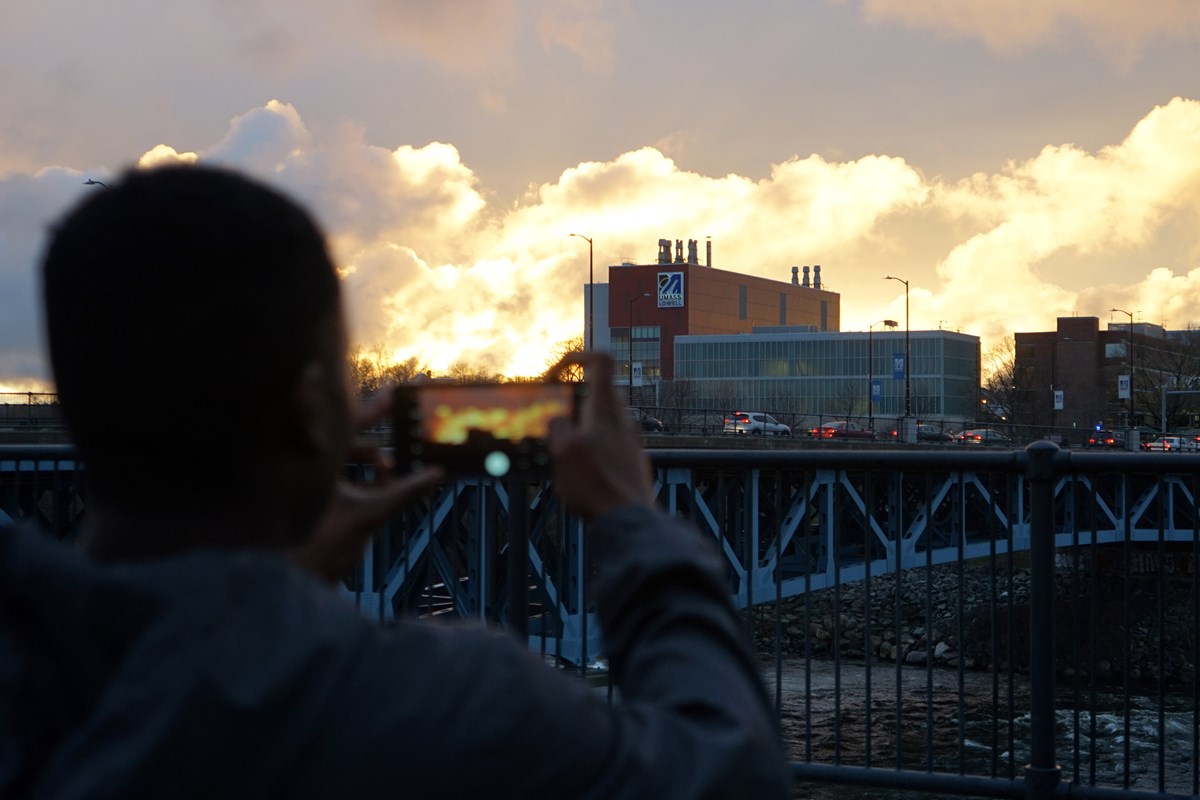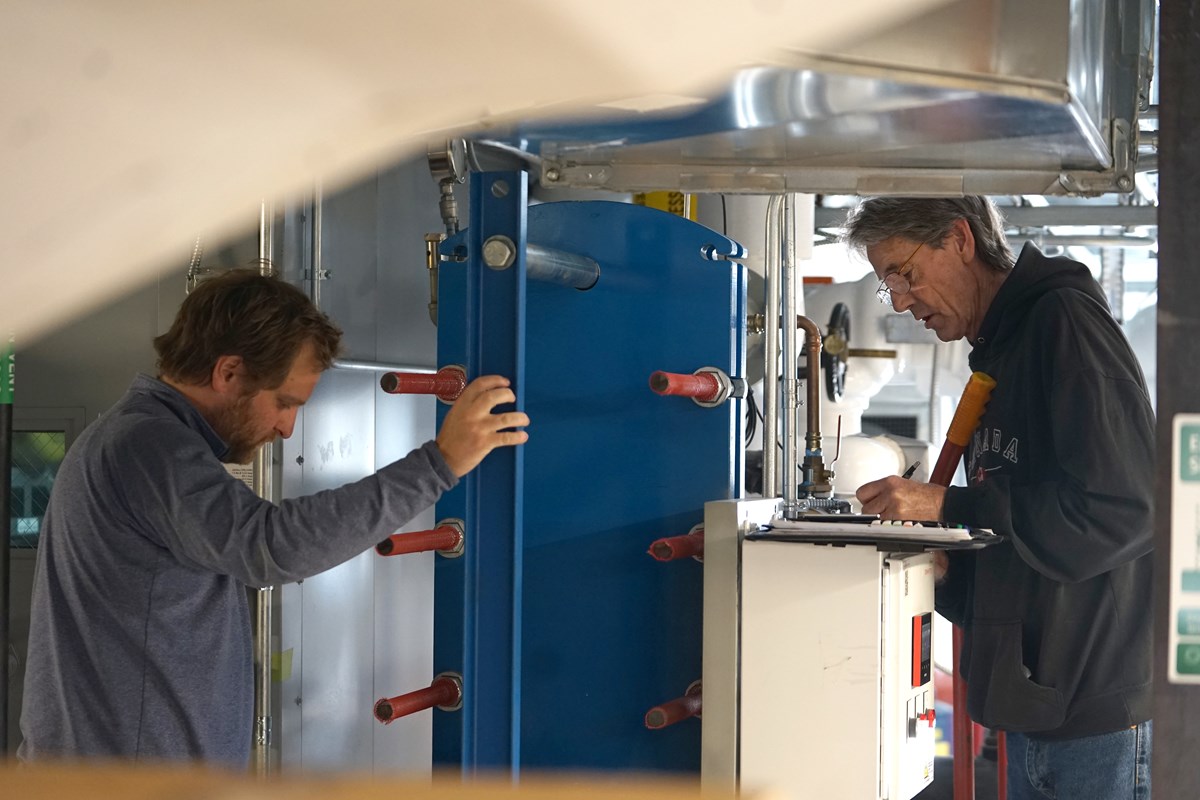 Image by Ed Brennen
Image by Ed Brennen
Building Energy Management System Technician James Santangelo works on the Automated Logic software for Perry Hall during last year's retro-commissioning, which ended up reducing the building's energy consumption by 30%.
If you have a programmable home thermostat, you know that calibrating it to your day-to-day schedule can lower your energy bill.
That’s essentially what UMass Lowell is doing with five buildings on campus, albeit on a much grander scale.
Facilities Management is leading “retro-commissioning” projects at Perry Hall, the Saab Emerging Technologies and Innovation Center (ETIC), Coburn Hall, the Pulichino Tong Business Center and the Campus Recreation Center.
Retro-commissioning is the process of analyzing and optimizing the performance of an existing building’s systems and equipment — think air-handling units, thermostats, lighting and plumbing — to ensure that they are operating efficiently and effectively. This can lead to better energy efficiency, reduced carbon dioxide (CO2) emissions, improved safety and comfort for occupants, and lower operating and maintenance costs.
“It looks at an entire building ecosystem and makes adjustments to the management system to run as efficiently and safely as possible,” says UML Energy Manager Dan Abrahamson.
 Image by Ed Brennen
Image by Ed Brennen
UML Energy Manager Dan Abrahamson, center, chats with Facilities Management colleague James Santangelo, left, and B2Q's Simon von Nieda at Perry Hall.
With the exception of the Campus Rec Center, all of the buildings are already LEED-certified (Leadership in Energy and Environmental Design) by the U.S. Green Building Council.
The university has partnered with B2Q Associates, an independent engineering consulting firm based in Andover, Massachusetts, to conduct the retro-commissioning work.
For a pilot project, the university chose Perry Hall, the North Campus engineering building that underwent a $50 million renovation in 2018.
“Now that the building is being used more and in different ways, it was a good opportunity to fine-tune the controls and get some savings,” says Abrahamson, who adds that the university’s computerized building management system, Automated Logic, is well-ingrained at Perry Hall.
B2Q analyzed the building in the spring of 2023 and identified dozens of measures that could result in a 30% reduction in its overall energy consumption. Building Energy Management System Technician James Santangelo then made changes to the Automated Logic software, “writing new sequences for the equipment,” he says, to implement the measures.
 Image by Ed Brennen
Image by Ed Brennen
A student snaps a photo of the sun setting behind the Saab Emerging Technologies and Innovation Center on North Campus. The building's recent retro-commissioning project is lowering its energy consumption by 18%, which will save the university $230,000 a year.
When B2Q recently performed a measurement verification, it found that the university had achieved 99% of the projected reductions at Perry Hall.
“It was a home run,” says Abrahamson, who notes that the fume hoods in Perry’s eight teaching and research labs were a big source of savings.
According to B2Q, the building now uses 33% less natural gas (25,000 therms per year) and 25% less electricity (285,000 kWh per year). The project also reduced Perry Hall’s carbon footprint by 30%, as its CO2 emissions have been slashed by 395,000 pounds per year — what a gas-powered car would emit by driving almost half a million miles.
Next in line for a retro-commission was Saab ETIC, which uses the most energy of any building on campus. Because Saab ETIC was constructed in multiple phases, Abrahamson says its building management system is more complex — so there’s more potential for efficiency improvements.
Indeed, B2Q reports that retro-commissioning has lowered ETIC’s electricity usage by 18% (958,000 kWH per year) and its natural gas usage by 17% (31,000 therms per year) — an 18% overall reduction in the building’s total energy usage. That translates to $230,000 in cost savings per year, which is more than 2% of the university’s entire annual utility budget.
The work has also reduced ETIC’s carbon footprint by 21%, or 713,000 pounds of CO2 per year.
 Image by Ed Brennen
Image by Ed Brennen
Retro-commissioning is the process of analyzing and optimizing the performance of a building's air-handling units, thermostats, lighting, plumbing and more.
While retro-commissioning isn’t cheap (Perry Hall cost about $175,000), Abrahamson says the projects can pay for themselves in as little as a year. Besides energy savings, the UMass system is part of a strategic energy management partnership with National Grid that provides incentives for meeting the kind of energy-saving goals achieved from the projects, he says.
Retro-commissioning also prolongs the life of building equipment, which saves money in the long run, Santangelo adds.
“And by maintaining the air pressures that these labs need to be at around the clock, they’re safer to work in,” he says.
In addition to B2Q’s upcoming work at Coburn Hall, Pulichino Tong and the Campus Rec Center, a separate retro-commissioning project recently kicked off at the McGauvran Center on South Campus — this one funded by the Division of Capital Asset Management and Maintenance (DCAMM).
Meanwhile, at Olsen Hall on North Campus, another project has the potential to automate the entire retro-commissioning process. National Grid recently funded a one-year study with a company called Simetric that, according to Abrahamson, will overlay software that can pull information directly from the building’s Automated Logic system and recommend improvements.
“Then it’s up to the Operations & Services team to review these measures and implement them on the fly,” Abrahamson says. “Not only does it prepare us for the future of artificial intelligence and automation, but it allows us to avoid doing these expensive studies. It makes the process a lot more efficient.”
The university also recently received DCAMM funding to install more energy-efficient LED lighting at Cumnock Hall, Lydon Library and the Campus Rec Center. The new lighting, which includes occupancy sensors and localized controls that can be programmed by phone, has saved nearly 20% in energy, Abrhamson says.
“The energy savings we’re seeing is similar to lighting systems that require an expensive server and a software-as-a-service platform to operate,” he says. “We only have the lights set to 60% output, and the buildings are much brighter than they were before.”
Santangelo looks forward to working with B2Q to fine-tune the software in building systems across campus.
“Seeing these outcomes makes all the hard work worth it,” he says.
